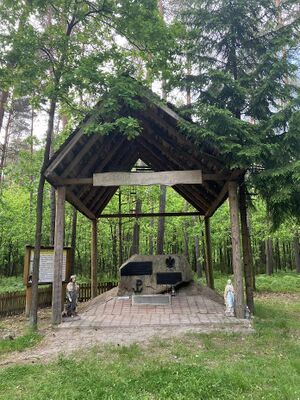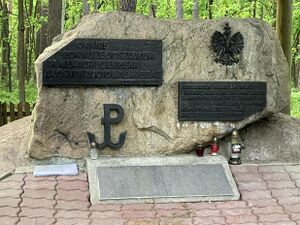Użytkownik:48323866/,,Baran'' (Little Katyn Podlaski): Różnice pomiędzy wersjami
(Utworzono nową stronę ",,Baran'' (Little Katyn Podlaski) a natural beauty spot in Poland, in Kakolewnica- Milolas, near Radzyn Podlaski, called Little Katyn by the local people. It's a forest clearing of the Baran where there have been found graves of murdered Polish people, and some of the graves are still not found yet. In this place, from the fall of 1944 to the turn of January and February 1945, during the stationing of the 2nd Polish People's Army, committed crimes, including those…") |
mNie podano opisu zmian |
||
| Linia 1: | Linia 1: | ||
,,Baran'' (Little Katyn Podlaski) a natural beauty spot in Poland, in Kakolewnica- Milolas, near Radzyn Podlaski, called Little Katyn by the local people. It's a forest clearing of the Baran where there have been found graves of murdered Polish people, and some of the graves are still not found yet. In this place, from the fall of 1944 to the turn of January and February 1945, during the stationing of the 2nd Polish People's Army, committed crimes, including those of the NKVD, carried out not only on soldiers of the Polish Independence formations AK, WiN, BCh, but also on the civilian population considered by the new authorities to be enemies suspected of anti-communist activities, a military court operating in the local school or basement sentenced 144 people in the cockle plant, including 61 deaths of which 43 murders were carried out, victims were sentenced to death or without sentence, were taken to the forest where the executions took place, bodies of the attacked during the investigation or murdered in other circumstances were also buried there, imprisoned, tortured, physically interrogated, mentally interrogated, and murdered, death sentences were approved by Soviet prosecutors and a military court. | ,,Baran'' (Little Katyn Podlaski) a natural beauty spot in Poland, in Kakolewnica- Milolas, near Radzyn Podlaski, called Little Katyn by the local people. It's a forest clearing of the Baran where there have been found graves of murdered Polish people, and some of the graves are still not found yet. In this place, from the fall of 1944 to the turn of January and February 1945, during the stationing of the 2nd Polish People's Army, committed crimes, including those of the NKVD, carried out not only on soldiers of the Polish Independence formations AK, WiN, BCh, but also on the civilian population considered by the new authorities to be enemies suspected of anti-communist activities, a military court operating in the local school or basement sentenced 144 people in the cockle plant, including 61 deaths of which 43 murders were carried out, victims were sentenced to death or without sentence, were taken to the forest where the executions took place, bodies of the attacked during the investigation or murdered in other circumstances were also buried there, imprisoned, tortured, physically interrogated, mentally interrogated, and murdered, death sentences were approved by Soviet prosecutors and a military court. | ||
[[Plik:Uroczysko ''Baran''.jpg|mały]] | |||
[[Plik:Uroczysko "Baran".jpg|mały]] | |||
The number of people executed here is unknown. The most cautious, say about several hundred victims, but others say 1300 to 1800 people killed. 30 young men arrested in the church in Trzebieszow, and soldiers from units across the river Bug, including the 27th Volhynian Infantry Division. He carried out the sentences of the military court, among others. Prison warden, Sergeant Bazyl Rogoz. The interrogations took place in Russian, there were many hours of conversations conducted at night, the sentences were carried out at night, after dark, covered trucks entered there and the sounds of shots reached the village from the forest, the murder was carried out with particular cruelty, the victims had their legs and hands tied with wire, the latter were shot on their backs. | |||
The bodies of people who were executed were shot in the back or side of the head. During the execution, they were thrown into nameless graves. From the accounts of people in the game, the sergeant carrying out the sentences was drunk since the morning, and it was known that he would shoot people at night. Shovels and pickaxes were seen being loaded onto trucks, and then bound and gagged people were thrown onto them like bags. According to the testimonies of the residents, when the headquarters was stationed, the forest was guarded by armed soldiers and no civilians were allowed to enter it. However, despite efforts to keep the crimes secret, there were witnesses who knew the locations of some graves or tried to find out what happens to people who disappear from their homes. Houses, such people included, among others, priest Lucjan Niedzielak, a parson in the Polskowola church, who was murdered in the rectory area only because he was collecting information on this subject. After burying the body, the area was leveled again and then covered with moss and young tree seedlings. In 1980, a symbolic grave was created. An official investigation was conducted. Started on March 8 year 1991, the remains of 12 men were found in an area of 10 m². Four separate graves were discovered, the condition of the remains and their location in the graves testified to the exceptional brutality of the executioners and the enormous suffering of the victims even before their deaths, probably the bones of the arms, legs and skulls were broken during the investigation at the time of death the convicts were wearing thick outerwear and sheepskin coats, which indicates that the executions happened in late autumn or winter, a large number of cartridge cases were also found at the place of death. | |||
Jozef Franczak was one of many that witnessed the murders himself, who after the Red Army entered these areas, was incorporated into the 2nd Polish Army (he deserted in January 1945) and got sent to Kakolewnica, where the military court martial was. | |||
On the initiative of the preacher in Kakolewnica and a resident of the commune, in May 1993, an iron cross, a huge boulder and three plaques commemorating those dramatic events took part at the place of execution. This monument replaces the symbolic grave from 1980. Every year in June, ceremonies dedicated to the fallen are held in which public authorities and church. In 2013 Bronislaw Komorowski, then the president of the Republic of Poland, laid flowers at this place. | |||
Wersja z 12:39, 23 maj 2024
,,Baran (Little Katyn Podlaski) a natural beauty spot in Poland, in Kakolewnica- Milolas, near Radzyn Podlaski, called Little Katyn by the local people. It's a forest clearing of the Baran where there have been found graves of murdered Polish people, and some of the graves are still not found yet. In this place, from the fall of 1944 to the turn of January and February 1945, during the stationing of the 2nd Polish People's Army, committed crimes, including those of the NKVD, carried out not only on soldiers of the Polish Independence formations AK, WiN, BCh, but also on the civilian population considered by the new authorities to be enemies suspected of anti-communist activities, a military court operating in the local school or basement sentenced 144 people in the cockle plant, including 61 deaths of which 43 murders were carried out, victims were sentenced to death or without sentence, were taken to the forest where the executions took place, bodies of the attacked during the investigation or murdered in other circumstances were also buried there, imprisoned, tortured, physically interrogated, mentally interrogated, and murdered, death sentences were approved by Soviet prosecutors and a military court.


The number of people executed here is unknown. The most cautious, say about several hundred victims, but others say 1300 to 1800 people killed. 30 young men arrested in the church in Trzebieszow, and soldiers from units across the river Bug, including the 27th Volhynian Infantry Division. He carried out the sentences of the military court, among others. Prison warden, Sergeant Bazyl Rogoz. The interrogations took place in Russian, there were many hours of conversations conducted at night, the sentences were carried out at night, after dark, covered trucks entered there and the sounds of shots reached the village from the forest, the murder was carried out with particular cruelty, the victims had their legs and hands tied with wire, the latter were shot on their backs.
The bodies of people who were executed were shot in the back or side of the head. During the execution, they were thrown into nameless graves. From the accounts of people in the game, the sergeant carrying out the sentences was drunk since the morning, and it was known that he would shoot people at night. Shovels and pickaxes were seen being loaded onto trucks, and then bound and gagged people were thrown onto them like bags. According to the testimonies of the residents, when the headquarters was stationed, the forest was guarded by armed soldiers and no civilians were allowed to enter it. However, despite efforts to keep the crimes secret, there were witnesses who knew the locations of some graves or tried to find out what happens to people who disappear from their homes. Houses, such people included, among others, priest Lucjan Niedzielak, a parson in the Polskowola church, who was murdered in the rectory area only because he was collecting information on this subject. After burying the body, the area was leveled again and then covered with moss and young tree seedlings. In 1980, a symbolic grave was created. An official investigation was conducted. Started on March 8 year 1991, the remains of 12 men were found in an area of 10 m². Four separate graves were discovered, the condition of the remains and their location in the graves testified to the exceptional brutality of the executioners and the enormous suffering of the victims even before their deaths, probably the bones of the arms, legs and skulls were broken during the investigation at the time of death the convicts were wearing thick outerwear and sheepskin coats, which indicates that the executions happened in late autumn or winter, a large number of cartridge cases were also found at the place of death.
Jozef Franczak was one of many that witnessed the murders himself, who after the Red Army entered these areas, was incorporated into the 2nd Polish Army (he deserted in January 1945) and got sent to Kakolewnica, where the military court martial was. On the initiative of the preacher in Kakolewnica and a resident of the commune, in May 1993, an iron cross, a huge boulder and three plaques commemorating those dramatic events took part at the place of execution. This monument replaces the symbolic grave from 1980. Every year in June, ceremonies dedicated to the fallen are held in which public authorities and church. In 2013 Bronislaw Komorowski, then the president of the Republic of Poland, laid flowers at this place.